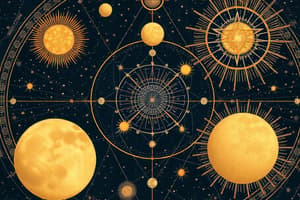Podcast
Questions and Answers
What is the primary reason for day and night on Earth?
What is the primary reason for day and night on Earth?
- The position of the Moon relative to the Earth
- The distance of the Earth from the Sun
- The Earth's orbit around the Sun
- The Earth's rotation on its axis (correct)
How long does it take for the Moon to complete one orbit around the Earth?
How long does it take for the Moon to complete one orbit around the Earth?
- 27.3 days (correct)
- 14 days
- 30.5 days
- 365.25 days
What is a leap year?
What is a leap year?
- A year occurring once every four years with 366 days (correct)
- A year that is shorter than usual
- A year occurring once every three years
- A year with 365 days
Which part of the Earth experiences daytime when facing the Sun?
Which part of the Earth experiences daytime when facing the Sun?
What does the solar system consist of?
What does the solar system consist of?
Why is the Sun essential for life on Earth?
Why is the Sun essential for life on Earth?
How long does it take for the Earth to complete one full rotation?
How long does it take for the Earth to complete one full rotation?
What is the shape of the Earth that affects sunlight exposure?
What is the shape of the Earth that affects sunlight exposure?
What is the main reason for adding an extra day to the calendar every four years?
What is the main reason for adding an extra day to the calendar every four years?
How often does a solar eclipse occur?
How often does a solar eclipse occur?
Why is New Zealand the first to see the sunrise compared to Australia?
Why is New Zealand the first to see the sunrise compared to Australia?
What occurs during a total solar eclipse?
What occurs during a total solar eclipse?
Who was al-Battani and what significant contribution did he make?
Who was al-Battani and what significant contribution did he make?
What is the difference between a total solar eclipse and a partial solar eclipse?
What is the difference between a total solar eclipse and a partial solar eclipse?
Which of the following accurately describes the term 'orbit' as it relates to planets?
Which of the following accurately describes the term 'orbit' as it relates to planets?
What causes day and night on Earth?
What causes day and night on Earth?
Flashcards are hidden until you start studying
Study Notes
Earth, Sun and Moon
- The solar system consists of planets, moons, asteroids, meteors and comets, orbiting the Sun.
- The Moon orbits the Earth in 27.3 days.
- The Earth orbits the Sun in 365.25 days.
Our Solar System
- The Sun is the closest star to Earth and provides energy for all life.
- Energy is created in the Sun through atom collisions.
- This energy is called Solar Energy.
Day and Night
- The Earth spins on its axis, an imaginary line through the North and South Pole.
- One rotation takes 24 hours, resulting in day and night.
- The Earth's shape exposes only half of the planet to sunlight at a time.
- The half facing the Sun experiences day and the opposite half experiences night.
A Year
- A year is the time it takes for a planet to orbit the Sun.
- The Earth takes 365.25 days to orbit the Sun.
- To account for the extra 0.25 days, a leap year with 366 days occurs every four years.
Solar Eclipse
- A solar eclipse occurs when the moon passes between the Sun and Earth.
- This happens every 27.3 days.
- During a total solar eclipse, the Moon blocks the Sun completely.
- During a partial solar eclipse, the Moon blocks only part of the Sun.
- The last total solar eclipse visible in Northern Australia was on 13 November 2012, the next will be on 20 April 2023, visible in Western Australia.
Studying That Suits You
Use AI to generate personalized quizzes and flashcards to suit your learning preferences.




